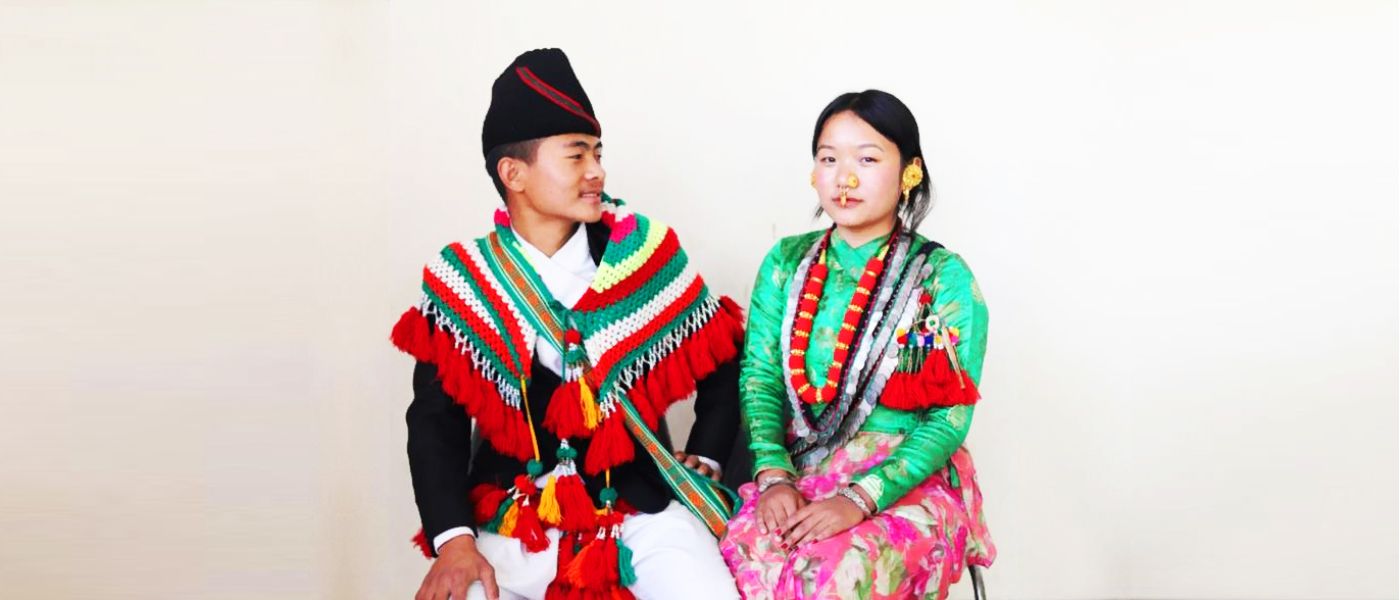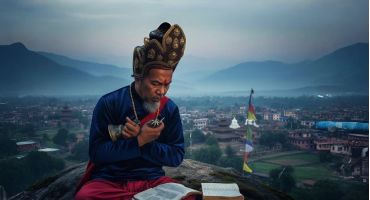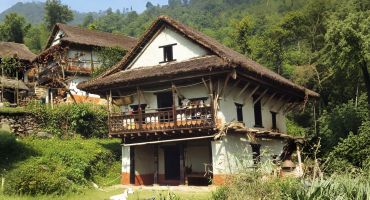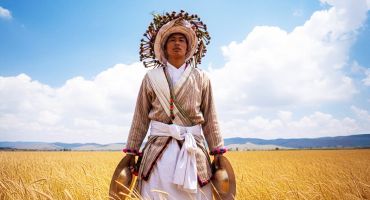For the Sunuwar Koits, history isn’t inscribed on parchment or pressed between the pages of books. It is carried in the stories of elders, held in the ritual chants, and guarded by shamans who traverse the liminal space between the physical and the unseen. Their myths of origin, their ancestral lineage, and the their traditions have only passed through the living memory of their people. Very little has been written about the Sunuwars, apart from a handful of books and academic papers. Among them, People of Nepal (1967) by Dor Bahadur Bista stands out where he speaks of twelve clans, the Bara Thars, mapping the Sunuwar presence along the watersheds of Likhu Khola and Khimti Khola, within the vast embrace of the Sun Koshi basin.
For the Sunuwar Kõits, identity has always been embedded in language and in the subtle architecture of words that give it meaning and purpose. Their name, Kõits, is drawn from the verb kõincha (kõitsā), meaning “to guide” or “to show.” It carries a sense of leadership that has been shaped by tribal hierarchy, and the reverence for the elders and traditional wisdom, where guidance is an act of understanding as well as survival. The word “Sunuwar,” was given by Nepali speakers and tied to the western banks of the Sunkoshi. However, it does point out to their geographical location and hints at how outsiders perceived and categorized them through place rather than through their own sense of belonging.

Furthermore, the Kõits identity has long been overshadowed by colonial constructs, with terms like “Sunuwar” and “Mukhiya” reducing a vibrant heritage to geographic or administrative labels. These exonyms, born of Indo-Aryan linguistic frameworks, strip the Kõits of their nuanced self-definition, while framing them within external perceptions of land and power. This has, in some sense, undermined their rich, self-constructed ethos. Nevertheless, the endonym Kõits has endured as a linguistic and cultural anchor, and defied the erasure of their heritage. It reminds the community of their deep historical ties to leadership, their indigenous lexicon’s capacity to preserve meaning, and the resilience of their ethnic identity. In reclaiming the term ‘Kõits’, the community reasserts a sovereignty of meaning, celebrating their role as custodians of ancestral wisdom.
The Kõits stand as inheritors of an ancient Kirati lineage, their lives bound to ancestral and shamanic devotion, along with an abiding kinship with the land. For them, every custom, rite, and daily life mirrors a profound attunement to both the natural world and the unseen forces that animate it.
The Bara Thars, or clans, serve as genealogical markers that define Sunuwar identity. Each clan branches into several subgroups that, despite their diversity, remain connected through a shared system of kinship and intermarriage. Some of these clans are Binicha, Bigyacha, Bujicha, Bramlicha, Darkhacha, terms that are remnants of an older wisdom, linking families to lost professions, forgotten geographies, and elemental truths. Some, like Phaticha, meaning “to filter,” speak to the ancient crafts of purification and separation, while Gongrocha— “to open noisily”—evokes the sharp report of thresholds crossed, of doors flung wide to new horizons.
The following are some of the Kõits clan names of Thars
- Binicha
- Bigyacha
- Bujicha
- Bramlicha
- Darkhacha
- Dasucha
- Debbacha
- Digarcha
- Durbicha
- Phaticha
- Gaurocha
- Gongrocha
- Jespucha
- Jijicha
- Jenticha
- Katicha
- Khunlicha
- Kyabacha
- Khyonpaticha
- Kyuinticha
- Kormocha
- Laspacha
- Linocha
- Lonkucha
- Lunkicha
- Mulicha
- Nasocha
- Ngawocha
- Nomlicha
- Pargacha
- Pretticha
- Rapicha
- Rawacha
- Rudicha
- Rujicha
- Rupacha
- Shyochulcha
- Susucha
- Teppacha
- Thangracha
- Tholocha
- Tonkucha
- Thungucha
- Tursucha
- Wangdecha
- Yatacha
Their language, casually termed Sunuwari, is actually called Kõits Lo. It is a branch of the Tibeto-Burman family, and serves a vessel of memory, a defiant marker of identity in a world that presses upon it, other than being a mere means of communication. Though the tide of Nepali influence and the weight of neighboring Hindu traditions have reshaped the cultural landscape, the Sunuwar remain steadfast, their language a thread binding them to the past, their ancestors, and to the land. This deep connection to the land is the foundation of their way of life. Agriculture dictates their rural existence, with terraced fields carved into the hillsides yielding millet, maize, and rice. Although hunters in the past, ingenious irrigation techniques have long been employed to foster abundance from the earth, yet the land itself is finite, its scarcity an ever-present challenge. Therefore, animal husbandry plays a lesser role, and has acted as a quiet supplement to an economy. In the fields, their unwavering traditions and in their language, the Sunuwar inscribe their history, ensuring that neither the soil nor the stories are ever lost.

Socially, the Sunuwar Kõits are organized into patrilineal clans that dictate familial lineage and social roles. Each clan has specific rituals that are performed to honor their ancestors, with a clear distinction between those who carry on the ancestral line and those who perform the rituals. Marriage within the Kõits society follows exogamous rules, ensuring that individuals marry outside their clan, which further reinforces their social cohesion and the interconnectedness of their clans. An interesting aspect of Kõits identity is their understanding of gender roles. In Sunuwar belief, ruysh (bones) are associated with male identity and patrilineal descent, while shey (flesh) represents the maternal lineage and female identity. This dualistic view of gender extends beyond social roles to their material and spiritual lives. For example, men inherit ancestral lands, which are seen as symbols of permanence, while women’s roles, though indispensable, are seen as transient in comparison.
Shamanism among the Kõits is both a spiritual practice and the axis upon which their world turns. Shamans are viewed as a sacred lineage of healers, seers, and intermediaries who walk the threshold between the living and the dead. To be a shaman is to wield Thung, an inherited power that grants the ability to heal, divine, and channel the voices of spirits. Rituals unfold in the flickering light of tradition, where bamboo, along with a host of other indigenous plants serve as the bridge between realms.
Sunuwar spiritual life is a delicate balance, a dual system upheld by the Naso, the elder who offers prayers and sacrifices, and the Puimbo or Ngiami, the shaman who traverses the spectral veil. Their rites are immersive acts and transform into ecstatic trances in which spirits speak, descend, and afflictions are torn from the afflicted. Shamans, once chosen by ancestral energies, work as an apprentice for experienced Shamans (Guru Thapnu) or are kidnapped by the mythical banjhakri, the forest spirit. The Banjhakri selects and initiates such novice Shamans, dragging them into the unknown, where the true apprenticeship begins. Through trials of endurance and revelations of power, the shaman emerges, armed with sacred incantations, divination rites, and the steady pulse of the drum.

In Sunuwar culture, gender symbolism takes on even more significance within the realm of shamanism. Sunuwar shamans, whether Puimbo (male) or Ngiami (female), transcend traditional gender roles and adopt an androgynous identity. This spiritual flexibility is crucial to their role as intermediaries between the living and the ancestral spirits. Shamans are believed to possess the power to enter trance states and communicate with the divine and the deceased, bridging the gap between the human and spiritual realms. This transcendent ability is facilitated by their unique gender identities, allowing them to embody the balance between masculine and feminine forces, a theme that is also evident in the Sunuwar’s material culture.
The forces of modernity, migration, urban expansion, the pull of mainstream education have, to an extent, eroded the foundations of Kõits tradition. Yet culture is not so easily erased. In villages and diaspora communities alike, a quiet resistance still takes shape. Grassroots movements emerge, language revitalization efforts take root, and ancestral knowledge passes from elders to youth. Among the youth, festivals have little events to rejuvenate ethnic consciousness. They serve as reaffirmations of a way of life that refuses to fade. Though the tides of change press in, the Sunuwar Kõits continue to hold fast, ensuring that their heritage is remembered and lived. Now, it falls upon the younger generation to bear this weight, to carry forward what remains, as a privilege, and also as a birthright.





Leave a Reply